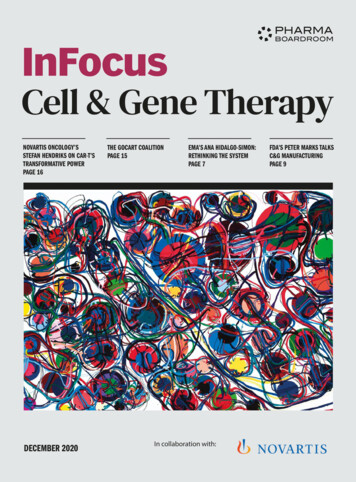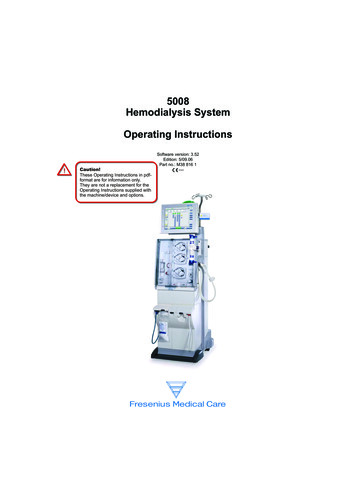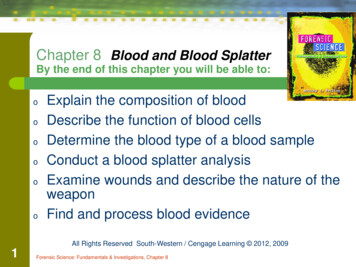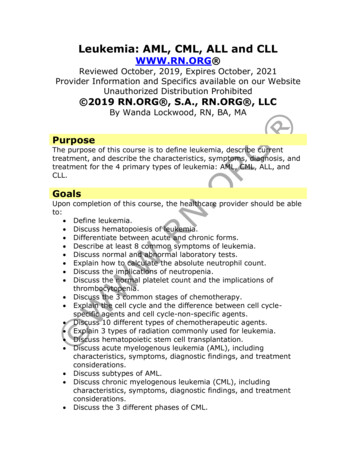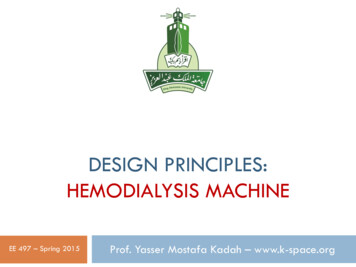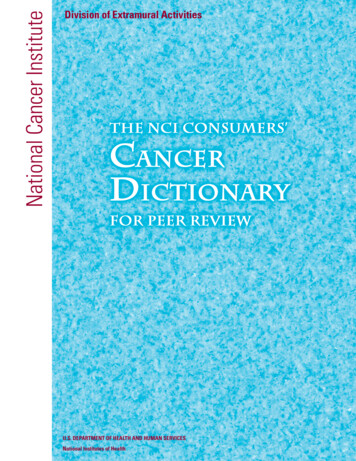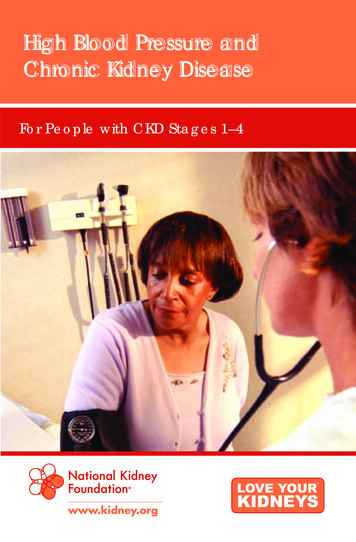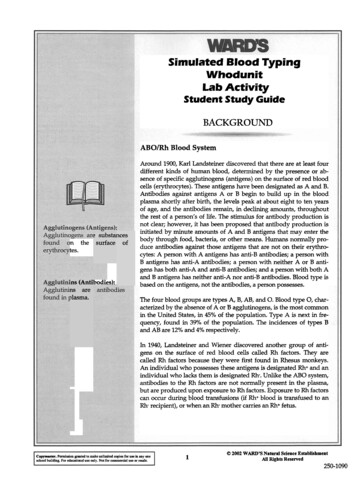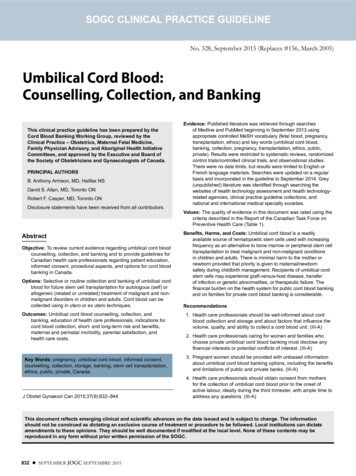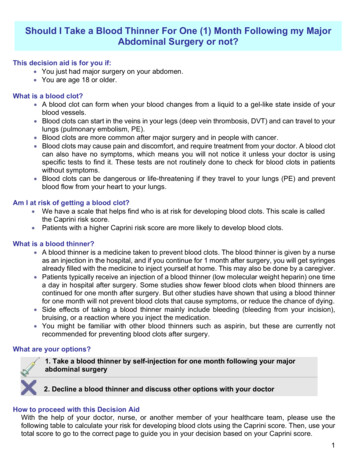
Transcription
Should I Take a Blood Thinner For One (1) Month Following my MajorAbdominal Surgery or not?This decision aid is for you if: You just had major surgery on your abdomen. You are age 18 or older.What is a blood clot? A blood clot can form when your blood changes from a liquid to a gel-like state inside of yourblood vessels. Blood clots can start in the veins in your legs (deep vein thrombosis, DVT) and can travel to yourlungs (pulmonary embolism, PE). Blood clots are more common after major surgery and in people with cancer. Blood clots may cause pain and discomfort, and require treatment from your doctor. A blood clotcan also have no symptoms, which means you will not notice it unless your doctor is usingspecific tests to find it. These tests are not routinely done to check for blood clots in patientswithout symptoms. Blood clots can be dangerous or life-threatening if they travel to your lungs (PE) and preventblood flow from your heart to your lungs.Am I at risk of getting a blood clot? We have a scale that helps find who is at risk for developing blood clots. This scale is calledthe Caprini risk score. Patients with a higher Caprini risk score are more likely to develop blood clots.What is a blood thinner? A blood thinner is a medicine taken to prevent blood clots. The blood thinner is given by a nurseas an injection in the hospital, and if you continue for 1 month after surgery, you will get syringesalready filled with the medicine to inject yourself at home. This may also be done by a caregiver. Patients typically receive an injection of a blood thinner (low molecular weight heparin) one timea day in hospital after surgery. Some studies show fewer blood clots when blood thinners arecontinued for one month after surgery. But other studies have shown that using a blood thinnerfor one month will not prevent blood clots that cause symptoms, or reduce the chance of dying. Side effects of taking a blood thinner mainly include bleeding (bleeding from your incision),bruising, or a reaction where you inject the medication. You might be familiar with other blood thinners such as aspirin, but these are currently notrecommended for preventing blood clots after surgery.What are your options?1. Take a blood thinner by self-injection for one month following your majorabdominal surgeryr2. Decline a blood thinner and discuss other options with your doctorHow to proceed with this Decision AidWith the help of your doctor, nurse, or another member of your healthcare team, please use thefollowing table to calculate your risk for developing blood clots using the Caprini score. Then, use yourtotal score to go to the correct page to guide you in your decision based on your Caprini score.1
Caprini Score Risk CalculationPlease work with your doctor, nurse, or another member of your healthcare team to calculate your riskscore. Your doctor, nurse or another member of your healthcare team will check off the boxes thatapply to you, add the points together to get a total score, and then direct you to the correct page to helpyou in making this decision.Each Risk Factor Represents 1 Point:I am 41-60 years oldWithin the last month, I have had surgery undergeneral or local anesthesia for MORE THAN 45minutesWithin the last month, I have had or currently havevaricose veinsWithin the last month, I have had or currently haveswollen legsWithin the last month, I have had a heart attackWithin the last month, I have had or currently havea serious infection for example, pneumonia,cellulitis, etc.I have a history of Inflammatory bowel disease(includes Crohn’s or ulcerative colitis)I have or have had congestive heart failureI have a chronic lung disease (for example COPD,emphysema) NOT including asthmaI have a scheduled surgery under general orregional anesthesia for LESS THAN 45 minutesBMI 25 kg/m2SUBTOTAL:Risk Factor Represents 5 Points:Within the past month, I have had a stroke (clot orhemorrhage in the brain, transient ischemicattack).SUBTOTAL:SUBTOTAL:Each Risk Factor Represents 3 Points:I am 75 or olderI have had a blood clot in my legs, arms,abdomen, or lungsThere is someone in my family (parents,grandparents, aunts, uncles, siblings, cousins)that has suffered from a blood clotI have been told that I have an abnormal bloodtest indicating an increased risk for blood clottingSUBTOTAL:Each Risk Factor Represents 2 Points:I am 61-74 years oldMy doctor told me I have cancer, leukemia,lymphoma, or melanomaIn the last month, I have had or currently have aPICC line, Port, or central venous accesscatheter in my neck or chest that delivers blood ormedicine directly into my heart.I have a scheduled surgery under general or localanesthesia for MORE THAN 45, minutesincluding laparoscopic surgeryFor Women Only: (Each Represents 1 Point)I currently use birth control (oral contraceptives,skin implantable devices, hormonal patches, IUDwith hormones, depo shot) or hormonereplacement therapy. Not including condoms orbarrier devices.I am currently pregnant or gave birth in the lastmonthI have a history of unexplained stillborn infant,MORE THAN 3 spontaneous abortions, prematurebirth with preeclampsia, or baby born smaller thanappropriate (low weight at birth).SUBTOTAL:TOTAL SCORE: (add subtotals together):If you scored 3 or 4: Proceed to page 3If you scored 5 or 6: Proceed to page 5If you scored 7 or 8: Proceed to page 7If you scored 9 or more: Proceed to page 9Working through the 4 steps of this decision aid may help you consider the options.2
CAPRINI SCORE: 3 OR 4Step 1: What are the benefits and harms of each option?What does the research show?The numbers below describe a ‘best estimate’ of what happens to 1000 people who take a bloodthinner for one month following major abdominal surgery. The shaded numbers show the number ofpeople affected. There is no way of knowing in advance if you will be affected.BenefitsTake blood thinnerIf 1000 people with a Caprini score of 3-4 take ablood thinner for one month following surgery, 4more people will avoid a blood clot compared tothose who do not take a blood thinner.997 avoid a blood clot,A blood clot may cause pain and discomfort, and 3 will get onerequire treatment from your doctor. A blood clotcan also have no symptoms – which means you willnot notice it unless your doctor is using specifictests to find it (these tests are not normally done).If 1000 people with a Caprini score of 3-4 take ablood thinner for one month following surgery, 1will avoid dying from a blood clot, which is thesame for people who decline a blood thinner.Decline993 avoid a blood clot,7 will get one 1,000 avoid dying, 1 will die 1,000 avoid dying, 1 will dieMinor HarmsIf 1000 people take a blood thinner, 5 more maydevelop bothersome minor bleeding.Clinically relevant minor bleeding is any amount ofbleeding that impacts your ability to perform dailyactivities, makes you seek medical attention, orcauses you to stop taking blood thinners. Forexample, minor bleeding from your surgical site.17 will bleed,983 will avoid this12 will bleed,988 will avoid thisSerious HarmsIf 1000 people take a blood thinner, 4 more peoplemay develop major bleeding compared to thosewho decline a blood thinner. Major bleeding mayrequire a blood transfusion, repeat surgery or mayresult in death. 14 will bleed,986 will avoid this 10 will bleed,990 will avoid thisStep 2. What matters most to you?Some common reasons to choose each option are listed below. Please mark with a checkmark howmuch each reason matters to you (1 means not important, 5 means very important).Reasons to take a blood thinnerHow important is it for you to avoid 1 month of treatment for a blood clot?How important is it for you to avoid a blood clot that could result in death?Other reasons:NotImportantVeryImportant0123450123453
NotImportantReasons to decline a blood thinnerVeryImportantHow important is it to you to avoid minor bleeding that affects your daily life?012345How important is it to you to avoid major bleeding that could result in death?012345Other reasons:Considering the options and what reasons are important to you, which option do you prefer?Check R one. take a blood thinner injection at home for one month following your surgery decline taking blood thinner injections at home following your surgery I am unsureStep 3: : Check Your UnderstandingCheck R the best Don’tknow 1. Which option has the highest chance ofavoiding a blood clot?2. Which option has the lowest chance ofdying from a blood clot?3. Which option has the lowest chance ofminor relevant bleeding?4. Which option has the highest chance ofmajor bleeding?Check your answers at the bottom of the page.Find out how comfortable you feel about deciding.Do you know the benefits and harms of each option?Yes No Are you clear about which benefits and risks matter most to you? Do you have enough support and advice to make a choice? Do you feel sure about the best choice for you? If you answered ‘No’ to any of these, discuss with your surgeon.(The SURE Test O’Connor & Légaré, 2008)Step 4: What are your next steps?Check R what you want to do next. I have decided to take a blood thinner at home for one month following my surgeryI have decided not to take a blood thinnerI need to discuss the options with my doctor/surgeon and family.I need to learn more about my options.This information is not intended to replace the advice of a health care provider.Answers for the key facts: 1. [A], 2. [C], 3. [B], 4. [A].4
CAPRINI SCORE: 5 OR 6Step 1: What are the benefits and harms of each option?What does the research show?The numbers below describe a ‘best estimate’ of what happens to 1000 people who take a bloodthinner for one month following major abdominal surgery. The shaded numbers show the number ofpeople affected. There is no way of knowing in advance if you will be affected.BenefitsTake blood thinnerIf 1000 people with a Caprini score of 5-6 take ablood thinner for one month following surgery, 10more will avoid a blood clot compared to thosewho decline a blood thinner.992 avoid a blood clot,A blood clot may cause pain and discomfort, and 8 will get onerequire treatment from your doctor. A blood clot canalso have no symptoms – which means you will notnotice it unless your doctor is using specific tests tofind it (these tests are not normally done).If 1000 people with a Caprini score of 5-6 take ablood thinner for one month following surgery, 1will avoid dying from a blood clot, which is thesame for people who decline a blood thinner.Minor HarmsIf 1000 people take a blood thinner, 5 more maydevelop bothersome minor bleedingcompared to those who decline a blood thinner.Clinically relevant minor bleeding is any amount ofbleeding that impacts your ability to perform dailyactivities, seek medical attention, or causes you tostop taking blood thinners. For example, minorbleeding from your surgical site.Serious HarmsIf 1000 people take a blood thinner, 4 more peoplemay develop major bleeding compared to thosewho decline a blood thinner. Major bleeding mayrequire a blood transfusion, repeat surgery or mayresult in death.Decline982 avoid a blood clot,18 will get one 1000 avoid dying, 1 will die 1000 avoid dying, 1 will die17 will bleed,983 will avoid this12 will bleed,988 will avoid this 14 will bleed,986 will avoid this 10 will bleed,990 will avoid thisStep 2. What matters most to you?Some common reasons to choose each option are listed below. Please mark with a checkmark howmuch each reason matters to you (1 means not important, 5 means very important).Reasons to take a blood thinnerHow important is it for you to avoid 1 month of treatment for a blood clot?How important is it to you to avoid a blood clot that could result in death?Other reasons:Reasons to decline a blood y5
ImportantImportantHow important is it to you to avoid minor bleeding that affects your daily life? 012345How important is it to you to avoid major bleeding that could result in death?123450Other reasons:Considering the options and what reasons are important to you, which option do you prefer?Check R one. take a blood thinner injection at home for one month following your surgery decline taking blood thinner injections at home following your surgery I am unsureStep 3: Check Your UnderstandingCheck R the best Don’tknow 1. Which option has the highest chance ofavoiding a blood clot?2. Which option has the lowest chance ofdying from a blood clot?3. Which option has the lowest chance ofminor relevant bleeding?4. Which option has the highest chance ofmajor bleeding?Check your answers at the bottom of the page.Find out how comfortable you feel about deciding.Do you know the benefits and harms of each option?Yes No Are you clear about which benefits and risks matter most to you? Do you have enough support and advice to make a choice? Do you feel sure about the best choice for you? If you answered ‘No’ to any of these, discuss with your surgeon.(The SURE Test O’Connor & Légaré, 2008)Step 4: What are your next steps?Check R what you want to do next. I have decided to take a blood thinner at home for one month following my surgeryI have decided not to take a blood thinnerI need to discuss the options with my doctor/surgeon and family.I need to learn more about my options.This information is not intended to replace the advice of a health care provider.Answers for the key facts: 1. [A], 2. [C], 3. [B], 4. [A].6
CAPRINI SCORE: 7 OR 8Step 1: What are the benefits and harms of each option?What does the research show?The numbers below describe a ‘best estimate’ of what happens to 1000 people who take a bloodthinner for one month following major abdominal surgery. The shaded numbers show the number ofpeople affected. There is no way of knowing in advance if you will be affected.BenefitsTake blood thinnerIf 1000 people with a Caprini score of 7-8 take ablood thinner for one month following surgery, 21more will avoid a blood clot compared to thosewho decline a blood thinner.981 avoid a blood clot,A blood clot may cause pain and discomfort, and 19 will get onerequire treatment from your doctor. A blood clot canalso have no symptoms – which means you will notnotice it unless your doctor is using specific tests tofind it (these tests are not normally done).If 1000 people with a Caprini score of 7-8 take ablood thinner for one month following surgery, 1will avoid dying from a blood clot, which is thesame for people who decline a blood thinner.Minor HarmsIf 1000 people take a blood thinner, 5 more maydevelop bothersome minor bleeding.Compared to those who decline a blood thinner.Clinically relevant minor bleeding is any amount ofbleeding that impacts your ability to perform dailyactivities, seek medical attention, or causes you tostop taking blood thinners. For example, minorbleeding from your surgical site.Serious HarmsIf 1000 people take a blood thinner, 4 morepeople may develop major bleeding compared tothose who decline a blood thinner. Major bleedingmay require a blood transfusion, repeat surgery ormay result in death.Decline960 avoid a blood clot,40 will get one 1000 avoid dying, 1 will die 1000 avoid dying, 1 will die17 will bleed,983 will avoid this12 will bleed,988 will avoid this 14 will bleed,986 will avoid this 10 will bleed,990 will avoid thisStep 2. What matters most to you?Some common reasons to choose each option are listed below. Please mark with a checkmark howmuch each reason matters to you (1 means not important, 5 means very important).Reasons to take a blood thinnerHow important is it for you to avoid 1 month of treatment for a blood clot?How important is it to you to avoid a blood clot that could result in death?Other reasons:NotImportantVeryImportant0123450123457
NotImportantReasons to decline a blood thinnerVeryImportantHow important is it to you to avoid minor bleeding that affects your daily life? 012345How important is it to you to avoid major bleeding that could result in death?123450Other reasons:Considering the options and what reasons are important to you, which option do you prefer?Check R one. take a blood thinner injection at home for one month following your surgery decline taking blood thinner injections at home following your surgery I am unsureStep 3: Check Your UnderstandingCheck R the best Don’tknow 1. Which option has the highest chance ofavoiding a blood clot?2. Which option has the lowest chance ofdying from a blood clot?3. Which option has the lowest chance ofminor relevant bleeding?4. Which option has the highest chance ofmajor bleeding?Check your answers at the bottom of the page.Find out how comfortable you feel about deciding.Do you know the benefits and harms of each option?Yes No Are you clear about which benefits and risks matter most to you? Do you have enough support and advice to make a choice? Do you feel sure about the best choice for you? If you answered ‘No’ to any of these, discuss with your surgeon.(The SURE Test O’Connor & Légaré, 2008)Step 4: What are your next steps?Check R what you want to do next. I have decided to take a blood thinner at home for one month following my surgeryI have decided not to take a blood thinnerI need to discuss the options with my doctor/surgeon and family.I need to learn more about my options.This information is not intended to replace the advice of a health care provider.Answers for the key facts: 1. [A], 2. [C], 3. [B], 4. [A].8
CAPRINI SCORE: 9 OR MOREStep 1: What are the benefits and harms of each option?What does the research show?The numbers below describe a ‘best estimate’ of what happens to 1000 people who take a bloodthinner for one month following major abdominal surgery. The shaded numbers show the number ofpeople affected. There is no way of knowing in advance if you will be affected.BenefitsTake blood thinnerIf 1000 people with a Caprini score of 9 or more takea blood thinner for 1 month following surgery, 57more will avoid a blood clot compared to thosewho decline a blood thinner. A blood clot may cause950 avoid a blood clot,pain and discomfort, and require treatment from 50 will get oneyour doctor. A blood clot can also have nosymptoms – which means you will not notice itunless your doctor is using specific tests to find it(these tests are not normally done.If 1000 people with a Caprini score of 9 or more takea blood thinner for 1 month following surgery, 0.28more will avoid dying from a blood clot comparedto those who decline a blood thinner.Minor HarmsIf 1000 people take a blood thinner, 5 more maydevelop clinically relevant bleeding compared tothose who decline a blood thinner. Clinicallyrelevant minor bleeding is any amount of bleedingthat impacts your ability to perform daily activities,seek medical attention, or causes you to stop takingblood thinners. For example, minor bleeding fromyour surgical site.Serious HarmsIf 1000 people take a blood thinner, 4 more peoplemay develop major bleeding compared to thosewho decline a blood thinner. Major bleeding mayrequire a blood transfusion, repeat surgery or mayresult in death.Decline893 avoid a blood clot,107 will get one 1000 avoid dying, 1 will die 1000 avoid dying,1 will die17 will bleed,983 will avoid this12 will bleed,988 will avoid this 14 will bleed,986 will avoid this 10 will bleed,990 will avoid thisStep 2. What matters most to you?Some common reasons to choose each option are listed below. Please mark with a checkmark howmuch each reason matters to you (1 means not important, 5 means very important).Reasons to take a blood thinnerHow important is it for you to avoid 1 month of treatment for a blood clot?How important is it to you to avoid a blood clot that could result in death?Other reasons:Reasons to decline a blood y9
ImportantImportantHow important is it to you to avoid minor bleeding that affects your daily life? 012345How important is it to you to avoid major bleeding that could result in death?123450Other reasons:Considering the options and what reasons are important to you, which option do you prefer?Check R one. take a blood thinner injection at home for one month following your surgery decline taking blood thinner injections at home following your surgery I am unsureStep 3: Check Your UnderstandingCheck R the best Don’tknow 1. Which option has the highest chance ofavoiding a blood clot?2. Which option has the lowest chance ofdying from a blood clot?3. Which option has the lowest chance ofminor relevant bleeding?4. Which option has the highest chance ofmajor bleeding?Check your answers at the bottom of the page.Find out how comfortable you feel about deciding.Do you know the benefits and harms of each option?Yes No Are you clear about which benefits and risks matter most to you? Do you have enough support and advice to make a choice? Do you feel sure about the best choice for you? If you answered ‘No’ to any of these, discuss with your surgeon.(The SURE Test O’Connor & Légaré, 2008)Step 4: What are your next steps?Check R what you want to do next. I have decided to take a blood thinner at home for one month following my surgeryI have decided not to take a blood thinnerI need to discuss the options with my doctor/surgeon and family.I need to learn more about my options.This information is not intended to replace the advice of a health care provider.Answers for the key facts: 1. [A], 2. [A], 3. [B], 4. [A]10
Last reviewed: February 3, 2022Content editors: Victoria Ivankovic, MD Candidate, Rebecca Auer, MSc, MD, FRCSC, *Marc Carrier MD, FRCPC, KristenMcAlpine, MD, FRCSCFunded in part by: The Ottawa Hospital Academic Medical Organization.Conflict of Interest: *1) Research funding: BMS, Pfizer and Leo Pharma *2) Honoraria: Bayer BMS, Leo Pharma, Pfizerand ServierThe authors did not stand to gain or lose from the choices patients make based on this decision aid. Funding had noinfluence on the content of the decision aid.This patient decision aid has been peer-reviewed. The patient decision aid will be updated in an ongoing fashion byauthors based on changes in studies published and feedback provided by users.Readability level 8.7 Flesch-KIncaidFormat based on the Ottawa Personal Decision Guide 2015, A O’Connor, D Stacey, University of Ottawa, Canada.REFERENCES FOR BENEFITS & HARMS DATA:Pannucci, C. J., Swistun, L., MacDonald, J. K., Henke, P. K., & Brooke, B. S. (2017). Individualized venousthromboembolism risk stratification using the 2005 Caprini score to identify the benefits and harms of chemoprophylaxis insurgical patients: a meta-analysis. Annals of surgery, 265(6), 1094-1103.Rausa, E., Kelly, M. E., Asti, E., Aiolfi, A., Bonitta, G., Winter, D. C., & Bonavina, L. (2018). Extended versus conventionalthromboprophylaxis after major abdominal and pelvic surgery: Systematic review and meta-analysis of randomized clinicaltrials. Surgery, 164(6), 1234-1240.Collins, R. (1988). Scrimgeour A, Yusuf S, Peto R. Reduction in fatal pulmonary embolism and venous thrombosis byperioperative administration of subcutaneous heparin. Overview of results of randomized trials in general, orthopedic, andurologic surgery. N Engl J Med, 318, 1162-1173.Douketis JD, Gu CS, Schulman S, Ghirarduzzi A, Pengo V, Prandoni P. The risk for fatal pulmonary embolism afterdiscontinuing anticoagulant therapy for venous thromboembolism. Ann Intern Med. Published online yman GH, Carrier M, Ay C, et al. American Society of Hematology 2021 guidelines for management of venousthromboembolism: Prevention and treatment in patients with cancer. Blood Adv. Published online 2021.doi:10.1182/bloodadvances.202000344211
blood thinner for one month following surgery, 1 will avoid dying from a blood clot, which is the same for people who decline a blood thinner. 1000 avoid dying, 1 will die 1000 avoid dying, 1 will die Minor Harms If 1000 people take a blood thinner, 5 more may develop bothersome minor bleeding compared to those
